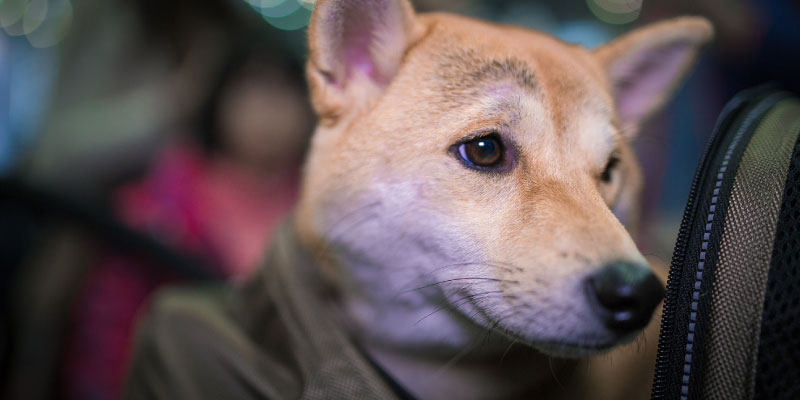They say a dog is a man’s best friend – so why wouldn’t you want your pup to accompany you on all your adventures? You just need the right equipment.
Whether you’re driving out long distances to explore new places, or just hiking in your local foothills, your dog makes a great companion.

But not all dogs can go the distance. You should always be careful to ensure your dogs fitness levels match yours, or understand that some breeds may never be able to keep up.
That’s where dog carriers come into play: but with so many out there, which one will suit you and your dog?
Why you might need to carry your dog
There’s nothing better than going on a long walk with your pup. However, be mindful that they may not always have the same stamina as you!
While larger breeds can walk up to 20 miles, it’s best not to go more than 10 with smaller dogs. You also need to consider their age and general fitness levels.
If you’re in it for the long haul, you may have to carry your dog. Of course, it’s not practical to carry your dog in your hands or in a handbag, so try here are the best dog carriers to help you carry your dog safely.
How to carry a dog safely
Before you even consider investing in a dog carrier for hiking, travelling or anything else, you need to be confident you can pick up your dog safely.
Generally speaking, it’s best to restrict the use of dog carriers to smaller breeds – you need to consider your own health as well as your dog’s.
However, there are some carriers out there for medium breeds, so it may simply be a case of checking your general health and fitness.
The first question is: how happy is your dog to be picked up? It may take some enticing to get your dog into a carrier, so you need to make sure you’ve established a mutual trust first.
Some dogs may be more anxious than others, so there’s no use trying to ask anybody to pick them up!
Start with a verbal command as a warning to your dog. They may react negatively if you simply sweep them off the floor! For smaller dogs, you can pick them up with one arm – generally up to the weight of around 5lb, like a Chihuahua.
For larger dogs, put your dominant arm behind the back legs and then wrap the other around its chest to form a comfortable, trusting bond.
Which dog carrier is best for me?
The best type of dog carrier for you will depend on your general strength and fitness levels, the size/weight of your dog, and the activity you’re doing.
As with all new equipment related to dogs, take things easy. Introduce the carrier on the floor, give the dog treats for coming closer and closer.
If you find they are happy to have a leg in one of the straps – reward! If you managed to get them in the carrier, reward, reward, reward! Even if just for a minute, the more happy associations a dog has with an item, them easier it will be for you to use that item in for the long haul.
If you are thinking you’ll be using a carrier with your puppy, it’s best to decide now what you’ll use and introduce it to them early. The earlier they get use to the idea, the easier it will be for them to jump onboard.
Carriers on wheels
For obvious reasons, this is no dog carrier for hiking! If you’re just taking a longer journey out on flat terrain, or if your pup isn’t in peak condition, a carrier on wheels can be a great alternative to a normal dog walk.
It may be you have a brachycephalic breed (Pugs, Bull dogs) and that whilst they may be happy to walk the hour around the park, but can’t bear the half an hour back to the house – it may save you carrying them if you bring your carrier with you.
But the good thing about carriers on wheels is that they can be used for larger breeds – generally up to around 20lb. This makes them ideal for dog breeds such as Basenjis, Cavalier King Charles Spaniels and Boston Terriers.
Good features to look out for are panels for your dog to see through, as well as additional compartments for those little essentials. Make sure you can unzip the carrier all the way around to get your dog in and out easily.
You may even want to consider how easily it can fit under seats, for example with car or train travel.
Finally, these don’t have to be limited to dogs either – many people use them for cats, or just making grocery shopping easier!
- Good for larger breeds up to 20lb
- Anxious dogs get a ‘hideyhole feel’
- Good for safe plane or train travel (where allowed)
- Can have multiple uses
- Can carry little extras (leads/ treats/water)
- Some dogs just don’t like feeling ‘caged’
- Only good for flat road surfaces – you won’t go hiking with these.
Across the shoulder pet carriers
A dog carrier sling is ideal for smaller dogs and those who can comfortably carry weights of up to 17lb, although most fit dogs up to 8 or 9lb.
Picture how long you can carry a baby for at these weights – you don’t want to commit to a long hike with added pressure on your back! If you don’t have a baby, imaging carrying around a small pumpkin all day on your front.
Pet slings are the practical puppy carrier alternative to fashion accessories. They are best for breeds such as Chihuahuas, Bichon Frises, Boston Terriers and Chinese Crested.
To optimise comfort for both you and your dog, look for a design that distributes weight evenly across your back, with wide straps.
Be mindful that older dogs may want to jump out of these, so in some breeds, it’s best to use them for puppies only.
A reliable across the shoulder carrier should have a harness and carrier loops with an ample pouch. Your pooch doesn’t want to feel cramped inside! Buy a natural fabric such as cotton to protect your dog’s skin – these are also easily washable.
- Chic and fashionable styles
- Great for small dog breeds
- Can be the most cost effective option
- Easily washables
- Keeps your hands free
- Allows the dog to look around and have more free movement
- The dog feels safe snuggled against you
- Some may carry dogs up to 17lb
- Most are only good for dogs up to 8lb or 9lb
Legs out front carriers
These are perhaps the most versatile for different sized dogs, plus they look super smart.
A good dog front carrier will come in sizes S to XL, but again, be mindful of how much weight you can comfortably carry.
If you’re feeling super fit, an XL can carry dogs weighing up to 22lb, so think Manchester Terriers, Shiba Inus and French Bulldogs.
Be mindful about using these kinds of carriers with puppies. They may want a little more movement and may not appreciate being ‘strapped in’.
However, once your dog is older and trusts you, a front carrier is great for walking and cycling! Look for a lightweight carrier with a breathable mesh to keep your dog comfortable and theres no uncomfortable rubbing on the legs.
Also make sure the straps are wide with padding to look after your shoulders and back.
- XL size can carry up to 22lb
- Hands free yet again!
- Dog doesn’t move as much as he/she is locked in place in front of you
- Good for more active activities where you need freedom of movement – cycling or hiking
- Spreads the weight of the dog more evenly across both shoulders
- Allows the dog to look around
- Gives dog feeling of safety sitting against you
- You can watch over your dog easily by looking down
- Easy to wash and made of breathable material for comfort
- Some dogs don’t like feeling restricted in legs and arms
- Ensure the carrier fits perfectly – you don’t want any rubbing causing sores or hurts.
Legs out backpacks
These are the perfect dog carriers for hiking. The front of your body is exposed and your hands are free to use any hiking tools like maps and walking aids.
These kinds of backpacks are best for dog breeds weighing up to 26lb, like a Basenji or a Schipperke.
You may even consider larger dogs as puppies, but again, be mindful that they may not want to be strapped in and may express discomfort.
The bigger the dog, the more difficult they may find being in carriers. That’s just a fact. So make sure the shop you buy it from has a good return policy if you are looking for something for a larger breed.
Again, the same applies here with front carriers – ensure there is plenty of padding for you and your dog, and only invest in breathable fabrics.
- Carry up to 26lb dog
- Full Hands free, nothing in the way
- Can usually carry a few extras thanks to pockets on the sides
- Great for hiking and long distance running
- Gives you the best weight distribution for safe carry
- Dog is strapped in and won’t move much
- Dog can look out onto the world
- Easy to wash and made from breathable materials
- Dog may not like being ‘strapped in’.
- Dog may get anxious if he can’t see you
- Can be the most challenging to teach your dog to ‘like’ unless introduced early
Pet carrier backpacks
If you want a little more mobility from your backpack, a generic pet carrier backpack will not fix your pup’s limbs in one place.
These can also be used for cats (though perhaps not best for long hikes with cats!) and generally carting equipment around.
These come in a number of different designs depending on your dog’s weight and size. For example, some may use a drawstring to keep your dog’s head in place, while others have a plastic lid that can be lifted off for your pet’s head.
Look for a water repellent, natural material for longer hikes.
As these backpacks are designed for dogs weighing up to 27lb, make sure they have ergonomic features.
Look for things such as padded backs, hip and back straps. Some even have removable metal rods to help them adjust to you and your pup.
- Some can carry up to 27lb
- Gives your dog more freedom of movement
- Look for the ergonomic features to ensure full comfort
- Great for long walks and hikes
- Some may allow dogs to look out onto the world
- Some may allow dogs to hide out from the world
- Evenly distributes your weight across your shoulders and back
- Dog is less secure on your back – no running or rapid movements as you don’t want them moving around everywhere.
- Some dogs don’t like feeling caged.
- Can be the more expensive option.
How to carry your dog safely
Ultimately, whatever kind of dog carrier you choose, you’ll want one that can withstand the elements and protect you and your dog’s health.
Ideally, look for one with added compartments to carry dog water, treats and anything else you may need to hike safely.
Also, don’t forget that dogs feel temperate differently from us. A short hair breed such as a dachshund may be happy in a pet carrier backpack, but a Havanese may struggle in the summer and be more comfortable in a ‘open air’ carrier.
Dogs may be reluctant at first to get into backpacks, so ease them in slowly. You can even get them to help you by carrying their ball!
5 quick steps to get them used to a dog carrier:
- Start off with it on the floor. Treat for putting them nose near it. Repeat as they get closer.
- If they are happy to go ‘in’ give them a treat. Take them out straight away. Repeat.
- Once comfortable, put them in, and then on you. Give them treat. Remove. Repeat as necessary.
- Give tour of the garden with it on. Give them treat, or make sure someone is at hand to give them treats.
- Start with shorter outdoor walks until your dog has eased itself into the backpack, and build up. First 10 then 20 then 30 minutes.
If at any point your dog freaks or starts whine or be uncomfortable stop and go back a step. This is suppose to be a place of fun, safety and adventure. If you dog puts a negative connection to the carrier, you won’t be able to use it in the future without causing him/her anxiety.
Then, once you’re more confident, you can try other activities like taking them on public transport and cycling.
This all depends on the breed and carrier, remember, so do what’s best for you and the dog.
There’s no reason why your dog shouldn’t accompany you on all your adventures, so be wise and accessorise with a carrier!




